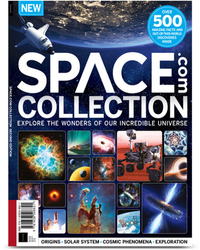
This could be the start of two brilliant scientific careers.
Two Massachusetts high schoolers — 16-year-old Kartik Pinglé and 18-year-old Jasmine Wright — have helped discover four new alien planets, a new study reports.
Pinglé and Wright are the second and third authors on the discovery paper, which was published online Monday (Jan. 25) in The Astronomical Journal. They did their otherworldly work via the Student Research Mentoring Program (SRMP) at the Harvard-Smithsonian Center for Astrophysics (CfA) and the Massachusetts Institute of Technology (MIT), which links up local high school students with scientists for year-long projects.
Gallery: The strangest alien planets
"By the end of the program, the students can say they've done active, state-of-the-art research in astrophysics," SRMP director Clara Sousa-Silva, a cosmochemist at MIT, said in a CfA statement.
Pinglé and Wright worked with Tansu Daylan, a postdoctoral researcher at MIT's Kavli Institute for Astrophysics and Space Research and the lead author of the new paper. Daylan and his colleagues — the study has dozens of co-authors — scrutinized observations of the sunlike star HD 108236 made by NASA's Transiting Exoplanet Survey Satellite (TESS).
TESS hunts for alien worlds via the "transit method," noting the tiny but telltale dips in stars' brightness caused when orbiting planets cross their faces from the spacecraft's perspective. The team confirmed four such planet-caused dips in the light curve of HD 108236, which lies about 200 light-years from Earth.
Get the Space.com Newsletter
Breaking space news, the latest updates on rocket launches, skywatching events and more!
Space.com Collection: $26.99 at Magazines Direct
Get ready to explore the wonders of our incredible universe! The "Space.com Collection" is packed with amazing astronomy, incredible discoveries and the latest missions from space agencies around the world. From distant galaxies to the planets, moons and asteroids of our own solar system, you’ll discover a wealth of facts about the cosmos, and learn about the new technologies, telescopes and rockets in development that will reveal even more of its secrets.
"I was very excited and very shocked," Wright said in the same statement. "We knew this was the goal of Daylan's research, but to actually find a multiplanetary system, and be part of the discovering team, was really cool."
Three of the four newfound worlds are gaseous planets slightly smaller than Neptune. The fourth is a super-Earth, a rocky planet a bit larger than our own, the researchers said. All four exoplanets lie very close to HD 108236; their orbital periods range from just under four Earth days to 19.5 Earth days.
For perspective: Our solar system's innermost planet, Mercury, completes one lap around the sun every 88 days.
The newfound HD 108236 worlds are intriguing and worthy of further study, Daylan said.
"Our species has long been contemplating planets beyond our solar system, and with multiplanetary systems, you're kind of hitting the jackpot," he said in the same statement. "The planets originated from the same disk of matter around the same star, but they ended up being different planets with different atmospheres and different climates due to their different orbits. So, we would like to understand the fundamental processes of planet formation and evolution using this planetary system."
Daylan also said he enjoyed working with Pinglé and Wright, who were paid four hours per week for their work via SRMP.
"They are salaried scientists," Sousa-Silva said. "We want to encourage them that pursuing an academic career is enjoyable and rewarding, no matter what they end up pursuing in life."
Pinglé and Wright may well keep going down the scientific path. Pinglé, a junior, is thinking about studying applied mathematics or astrophysics after graduation, according to the CfA statement. And Wright has been accepted into a five-year-long Master of Astrophysics program at the University of Edinburgh in Scotland.
Mike Wall is the author of "Out There" (Grand Central Publishing, 2018; illustrated by Karl Tate), a book about the search for alien life. Follow him on Twitter @michaeldwall. Follow us on Twitter @Spacedotcom or Facebook.
Join our Space Forums to keep talking space on the latest missions, night sky and more! And if you have a news tip, correction or comment, let us know at: community@space.com.

Michael Wall is a Senior Space Writer with Space.com and joined the team in 2010. He primarily covers exoplanets, spaceflight and military space, but has been known to dabble in the space art beat. His book about the search for alien life, "Out There," was published on Nov. 13, 2018. Before becoming a science writer, Michael worked as a herpetologist and wildlife biologist. He has a Ph.D. in evolutionary biology from the University of Sydney, Australia, a bachelor's degree from the University of Arizona, and a graduate certificate in science writing from the University of California, Santa Cruz. To find out what his latest project is, you can follow Michael on Twitter.










